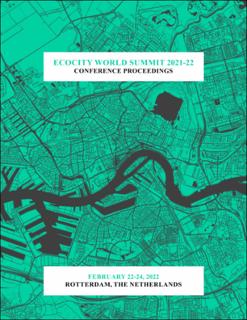Please use this identifier to cite or link to this item:
https://doi.org/10.21256/zhaw-26682Full metadata record
| DC Field | Value | Language |
|---|---|---|
| dc.contributor.author | Durrer, Brenda | - |
| dc.contributor.author | Perritaz, Edmée | - |
| dc.contributor.author | Catalano, Chiara | - |
| dc.date.accessioned | 2023-01-19T15:59:33Z | - |
| dc.date.available | 2023-01-19T15:59:33Z | - |
| dc.date.issued | 2022-11 | - |
| dc.identifier.isbn | 978-0-578-77618-7 | de_CH |
| dc.identifier.uri | https://ecocitybuilders.org/wp-content/uploads/2022/11/EWS-21-22-Proceedings.pdf | de_CH |
| dc.identifier.uri | https://digitalcollection.zhaw.ch/handle/11475/26682 | - |
| dc.description.abstract | In urban areas, the promotion of biodiversity is gaining importance. On the one hand, biodiversity is dwindling due to intensive agriculture and the loss of habitats; on the other, cities offer a variety of suitable microclimatic conditions for plant communities and animals, which can be implemented through sustainable planning. This work aimed to develop a feasible concept for a building envelope to promote biodiversity, considering the surrounding habitats while addressing the specific needs of target animal species. This required a close cooperation between architects and environmental engineers. The study case selected was a family house in Gattikon (Zurich, Switzerland), belonging to the Swiss architectural office VBAU and subjected to renovation. First, a site analysis was run to map local habitats, animal species occurrence and wildlife barriers, and simulate the time exposure to sunlight/ shadows on the building envelope. Second, the criteria to rule out habitats and species was identified following an exclusion procedure. As a result, three habitats and six animal species were selected. Last, a concept for the design of the facade on the base of the ecological analysis results was developed. Bricks were used as suitable material to create a structured green facade that mimics the selected habitats while meeting the ecological requirements of the selected target plant and animal species. In conclusion, considering both the habitats as a model and the life cycle of the target animal species enabled the selection of plant species to green the facades without missing the survival needs of animal species. | de_CH |
| dc.language.iso | en | de_CH |
| dc.publisher | Ecocity Builders | de_CH |
| dc.rights | Not specified | de_CH |
| dc.subject | Animal-aided design | de_CH |
| dc.subject | Biodiversity | de_CH |
| dc.subject | Building envelope | de_CH |
| dc.subject | Brick | de_CH |
| dc.subject | Ecological design | de_CH |
| dc.subject | Facade | de_CH |
| dc.subject | Green architecture | de_CH |
| dc.subject | Urban habitat | de_CH |
| dc.subject.ddc | 728: Wohnbauten | de_CH |
| dc.title | Designing for biodiversity : conceptualization of a sustainable building envelope for a single-family house in Switzerland | de_CH |
| dc.type | Konferenz: Paper | de_CH |
| dcterms.type | Text | de_CH |
| zhaw.departement | Life Sciences und Facility Management | de_CH |
| zhaw.organisationalunit | Institut für Umwelt und Natürliche Ressourcen (IUNR) | de_CH |
| zhaw.publisher.place | Oakland | de_CH |
| dc.identifier.doi | 10.21256/zhaw-26682 | - |
| zhaw.conference.details | 14th Ecocity World Summit, Rotterdam, The Netherlands, 22-24 February 2022 | de_CH |
| zhaw.funding.eu | No | de_CH |
| zhaw.originated.zhaw | Yes | de_CH |
| zhaw.pages.end | 169 | de_CH |
| zhaw.pages.start | 157 | de_CH |
| zhaw.publication.status | publishedVersion | de_CH |
| zhaw.publication.review | Keine Begutachtung | de_CH |
| zhaw.title.proceedings | Ecocity World Summit 2021-22 Conference Proceedings | de_CH |
| zhaw.webfeed | Grünraumentwicklung | de_CH |
| zhaw.author.additional | No | de_CH |
| zhaw.display.portrait | Yes | de_CH |
| Appears in collections: | Publikationen Life Sciences und Facility Management | |
Files in This Item:
| File | Description | Size | Format | |
|---|---|---|---|---|
| 2022_Durrer-etal_Designing-for-biodiversity_EWS.pdf | 1.95 MB | Adobe PDF |  View/Open |
Show simple item record
Durrer, B., Perritaz, E., & Catalano, C. (2022). Designing for biodiversity : conceptualization of a sustainable building envelope for a single-family house in Switzerland [Conference paper]. Ecocity World Summit 2021-22 Conference Proceedings, 157–169. https://doi.org/10.21256/zhaw-26682
Durrer, B., Perritaz, E. and Catalano, C. (2022) ‘Designing for biodiversity : conceptualization of a sustainable building envelope for a single-family house in Switzerland’, in Ecocity World Summit 2021-22 Conference Proceedings. Oakland: Ecocity Builders, pp. 157–169. Available at: https://doi.org/10.21256/zhaw-26682.
B. Durrer, E. Perritaz, and C. Catalano, “Designing for biodiversity : conceptualization of a sustainable building envelope for a single-family house in Switzerland,” in Ecocity World Summit 2021-22 Conference Proceedings, Nov. 2022, pp. 157–169. doi: 10.21256/zhaw-26682.
DURRER, Brenda, Edmée PERRITAZ und Chiara CATALANO, 2022. Designing for biodiversity : conceptualization of a sustainable building envelope for a single-family house in Switzerland. In: Ecocity World Summit 2021-22 Conference Proceedings [online]. Conference paper. Oakland: Ecocity Builders. November 2022. S. 157–169. ISBN 978-0-578-77618-7. Verfügbar unter: https://ecocitybuilders.org/wp-content/uploads/2022/11/EWS-21-22-Proceedings.pdf
Durrer, Brenda, Edmée Perritaz, and Chiara Catalano. 2022. “Designing for Biodiversity : Conceptualization of a Sustainable Building Envelope for a Single-Family House in Switzerland.” Conference paper. In Ecocity World Summit 2021-22 Conference Proceedings, 157–69. Oakland: Ecocity Builders. https://doi.org/10.21256/zhaw-26682.
Durrer, Brenda, et al. “Designing for Biodiversity : Conceptualization of a Sustainable Building Envelope for a Single-Family House in Switzerland.” Ecocity World Summit 2021-22 Conference Proceedings, Ecocity Builders, 2022, pp. 157–69, https://doi.org/10.21256/zhaw-26682.
Items in DSpace are protected by copyright, with all rights reserved, unless otherwise indicated.